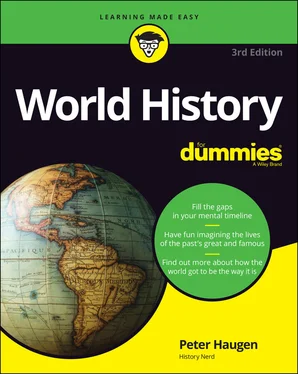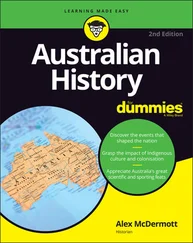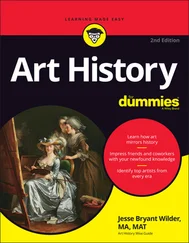Peter Haugen - World History For Dummies
Здесь есть возможность читать онлайн «Peter Haugen - World History For Dummies» — ознакомительный отрывок электронной книги совершенно бесплатно, а после прочтения отрывка купить полную версию. В некоторых случаях можно слушать аудио, скачать через торрент в формате fb2 и присутствует краткое содержание. Жанр: unrecognised, на английском языке. Описание произведения, (предисловие) а так же отзывы посетителей доступны на портале библиотеки ЛибКат.
- Название:World History For Dummies
- Автор:
- Жанр:
- Год:неизвестен
- ISBN:нет данных
- Рейтинг книги:3 / 5. Голосов: 1
-
Избранное:Добавить в избранное
- Отзывы:
-
Ваша оценка:
- 60
- 1
- 2
- 3
- 4
- 5
World History For Dummies: краткое содержание, описание и аннотация
Предлагаем к чтению аннотацию, описание, краткое содержание или предисловие (зависит от того, что написал сам автор книги «World History For Dummies»). Если вы не нашли необходимую информацию о книге — напишите в комментариях, мы постараемся отыскать её.
World History For Dummies,
For Dummies
World History For Dummies
World History For Dummies — читать онлайн ознакомительный отрывок
Ниже представлен текст книги, разбитый по страницам. Система сохранения места последней прочитанной страницы, позволяет с удобством читать онлайн бесплатно книгу «World History For Dummies», без необходимости каждый раз заново искать на чём Вы остановились. Поставьте закладку, и сможете в любой момент перейти на страницу, на которой закончили чтение.
Интервал:
Закладка:
Dr. Martin Luther King, Jr. (1929–68): King was inspired by Mahatma Gandhi to use nonviolent protest against racial discrimination in the United States in the 1950s and 1960s. He played a major role in winning popular support for the landmark Civil Rights Act of 1964, legislation that outlawed segregation by race in schools, in the workplace, and at public facilities.
Gandhi and King brought about change and stirred resistance. Each was human, and humans are flawed. Gandhi has been accused, posthumously, of racism toward blacks during the 21 years that he lived in South Africa before returning to India. While King was still alive, the Federal Bureau of Investigation accused him of having extramarital affairs. Yet each man sought to make the world better, and both arguably succeeded to some extent. Had their efforts been entirely in vain, Gandhi and King may have been seen as ineffectual dreamers. (Turn to Chapter 22for more about Gandhi and King.)
Tracking the Centuries
About 4.5 billion BC:Earth forms.
Maybe 4 million BC:Early hominids (humanlike ancestors) walk on their hind legs. (Some evidence points to evidence of even earlier apelike bipeds.)
About 700,000 BC:Homo erectus walks out of Africa.
About 60,000 BC:Human beings leave behind early examples of art.
479–323 BC:The Classical Greek era gives rise to democracy.
1605:The Gunpowder Plot against England’s King James I is foiled when conspirator Guy Fawkes is caught with explosives below the assembly hall of Parliament.
1789:George Washington is elected president of the United States of America.
1948:An assassin kills Mahatma Gandhi.
1968:An assassin kills Dr. Martin Luther King, Jr.
Part 2
Finding Strength in Numbers
IN THIS PART …
Visit the earliest cities, seeing how ancient people learned to work together for mutual benefit and how defensive alliances, commerce, and conquest spread written language, law, and new ways of thinking.
Follow the rise of the Roman Republic, which grew into an empire whose influence is still felt today, and see how other ancient empires rose and fell.
Discover how the Middle Ages, an unsettled time of migrations and regional conflicts, set the stage for modern nations.
See how the rise of Islam reshaped vast parts of Asia, Africa, and even Europe, and how the Crusades and the Silk Road fed Western appetites for trade with India and East Asia.
Follow new sea routes that enabled a handful of European powers to claim pieces of every other habitable continent as components of worldwide empires and get a glimpse of how colonial residents chafed at foreign control.
Find out about the push and pull of globalism as imperial powers, eventually enabled by technologies such as the steam engine and the telegraph, extended their reach even while subject people fought to break their ties with European overlords.
Chapter 4
Getting Civilized
IN THIS CHAPTER
 Touring Jericho, maybe the oldest city
Touring Jericho, maybe the oldest city
 Drawing a connection between rivers and budding civilizations
Drawing a connection between rivers and budding civilizations
 Starting a written record
Starting a written record
 Going conquering with the Greeks and Alexander
Going conquering with the Greeks and Alexander
Human beings lived without cities — with none of what people today call civilization — much longer than people have lived with cities and civilization. Archaeologists can’t find much evidence that anything that could be called a city existed until at least 10,000 years ago, although there are older ruins that show the beginnings of cities. The people of 20,000 years ago may have thought about large permanent settlements as impractical — that is, if the idea ever occurred to them — because the way to get food reliably was to remain mobile. If you wanted to eat, you went where the plants were thriving, where the shellfish clung to the river rocks, and where herds and flocks migrated. You followed food sources season by season, and as you wandered, you took care not to merge your band of wanderers with other bands. It wasn’t a good idea to have too many mouths to feed.
But even before they fully adopted agriculture, as early as 11,000 years back, humans got together in great numbers for impressive building projects. The ruins at Göbekli Tepe in southern Turkey give evidence. More than 200 T-shape stone pillars, each about 20 feet high, are arranged in 20 circles. There are no nearby ruins of dwellings, so researchers think the circles may have been a site of worship or ritual burial for a hunter-gatherer society. Ruins at Tel Qarmel, in northern Syria, also include stone towers that may be older than farming. That fact makes such finds more impressive — and more mysterious.
When the practice of farming did get people to settle down, communities followed, and grew — villages to towns, towns to cities. By 10,000 years ago, Jericho, a city on today’s Palestinian West Bank, was either welcoming travelers who happened by their oasis or chasing them away with rocks and spears thrown from the town’s protective walls and tower.
Archaeologists know quite a bit about early civilizations, especially those that rose along major rivers in Iraq and Egypt. It helps that Iraq and Egypt are also where people invented writing. When the written record began, prehistory could grow into history.
Cities developed not just in the Middle East, but also in Pakistan, India, and China, where great civilizations have risen and receded as they interacted with the rest of the world over 3,000 or 4,000 years. They also arose in the Americas, where Europeans and the diseases they carried wiped out advanced native societies in the 16th century AD.
In this chapter, you can find out about early civilizations and how their ruins teach us about people gathering, collaborating, and trading in greater numbers as they recognized shared needs for safety, sustenance, order, and justice. Forms of law, religion, and philosophy developed and led, by a long, circuitous path, to modern ways of thinking and governing. They developed systems of writing, without which we couldn’t study history. The world that you and I know started to take shape in those first urban societies as cities grew into city-states, civilizations, and eventually empires.
Building Jericho’s Walls for Mutual Defense
The Bible says that Joshua and the Israelites raised a ruckus that brought down the walls of Jericho, a city in Canaan (today’s Palestinian-administered West Bank). Jericho appears to be one of the world’s oldest cities; it predates even the early civilizations along the Tigris and Euphrates rivers in modern Iraq. What the Bible doesn’t say is that Jericho’s walls of perhaps 3,200 years ago were built on top of walls that were built on top of walls. (Maybe that’s why those walls toppled so easily when Joshua and his posse arrived.) Scientists date the settlement’s earliest buildings to as early as 9000 BC, which is about 11,000 years ago. True, Jericho was abandoned and rebuilt maybe 20 times, but when you’re talking about thousands of years, what are 20 do-overs?
Читать дальшеИнтервал:
Закладка:
Похожие книги на «World History For Dummies»
Представляем Вашему вниманию похожие книги на «World History For Dummies» списком для выбора. Мы отобрали схожую по названию и смыслу литературу в надежде предоставить читателям больше вариантов отыскать новые, интересные, ещё непрочитанные произведения.
Обсуждение, отзывы о книге «World History For Dummies» и просто собственные мнения читателей. Оставьте ваши комментарии, напишите, что Вы думаете о произведении, его смысле или главных героях. Укажите что конкретно понравилось, а что нет, и почему Вы так считаете.












